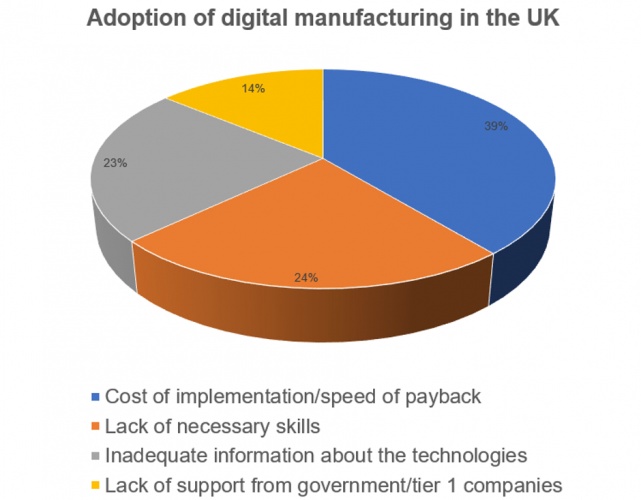
Digital manufacturing could help reduce production costs and decrease time to market, but uptake of these enabling technologies seems slow in the UK.
The umbrella term covers everything from robotics, digital twins and Internet of Things/industry 4.0 sensor-and AI-equipped equipment to additive manufacturing and computer-aided design and manufacturing IT tools.
The Digital Catapult estimates that the UK economy could grow by £455bn, create 175,000 new jobs increase productivity and cut CO2 emissions via the early adoption of advanced digital technologies in the next decade.
So, what is hindering the adoption of digital manufacturing in Britain? According to our poll, 39 per cent see the cost of implementation/ROI as the biggest barrier, followed by 24 per cent who see problems with skills deficiencies. This view is followed closely by the 23 per cent of respondents who feel they lack adequate information about available technologies, then 14 per cent who feel that government and Tier 1 companies are failing to adequately support industry uptake by smaller suppliers.
Semantics appeared to be an issue for some who responded to the poll, with several wondering what ‘digital manufacturing’ means.
“The use of the term ‘digital’ is about as much use at the current vogue for calling every electronic device ‘tech’,” said Sandy.
“I agree that there is lots of confusion about what 'digital manufacturing' really means,” added Richard. “For me it is about using automation to streamline manufacturing and business processes to make them more efficient.”
What do you think? Keep the debate alive using Comments below, but please familiarise yourselves with our code of conduct.
Before we go, a plug for some related content that will be published soon. Late last year, The Engineer hosted a large-scale roundtable on digital manufacturing, supported by BAE Systems and involving organisations from the supply chain, through R&D, and all the way through to tier 1 manufacturers in the aerospace and automotive spheres. A write up of the discussion will be published in our February issue and online.





IEA report claims batteries are ‘changing the game’
It is important in trucks and other commercial vehicles as the payload will be reduced if the battery weight is penal. Battery applications in the...